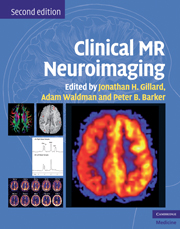Book contents
- Frontmatter
- Contents
- Contributors
- Case studies
- Preface to the second edition
- Preface to the first edition
- Abbreviations
- Introduction
- Section 1 Physiological MR techniques
- Section 2 Cerebrovascular disease
- Section 3 Adult neoplasia
- Section 4 Infection, inflammation and demyelination
- Chapter 27 Physiological imaging in infection, inflammation and demyelination
- Chapter 28 Magnetic resonance spectroscopy in intracranial infection
- Chapter 29 Diffusion and perfusion MR imaging of intracranial infection
- Chapter 30 Magnetic resonance spectroscopy in demyelination and inflammation
- Chapter 31 Diffusion and perfusion MRI in inflammation and demyelination
- Chapter 32 Physiological MR to evaluate HIV-associated brain disorders
- Section 5 Seizure disorders
- Section 6 Psychiatric and neurodegenerative diseases
- Section 7 Trauma
- Section 8 Pediatrics
- Section 9 The spine
- Index
- References
Chapter 30 - Magnetic resonance spectroscopy in demyelination and inflammation
from Section 4 - Infection, inflammation and demyelination
Published online by Cambridge University Press: 05 March 2013
- Frontmatter
- Contents
- Contributors
- Case studies
- Preface to the second edition
- Preface to the first edition
- Abbreviations
- Introduction
- Section 1 Physiological MR techniques
- Section 2 Cerebrovascular disease
- Section 3 Adult neoplasia
- Section 4 Infection, inflammation and demyelination
- Chapter 27 Physiological imaging in infection, inflammation and demyelination
- Chapter 28 Magnetic resonance spectroscopy in intracranial infection
- Chapter 29 Diffusion and perfusion MR imaging of intracranial infection
- Chapter 30 Magnetic resonance spectroscopy in demyelination and inflammation
- Chapter 31 Diffusion and perfusion MRI in inflammation and demyelination
- Chapter 32 Physiological MR to evaluate HIV-associated brain disorders
- Section 5 Seizure disorders
- Section 6 Psychiatric and neurodegenerative diseases
- Section 7 Trauma
- Section 8 Pediatrics
- Section 9 The spine
- Index
- References
Summary
Introduction
MR spectroscopy (MRS) furnishes in vivo metabolic information in central nervous system (CNS) diseases. This chapter addresses the application of proton MRS to the study of acquired demyelinating and inflammatory disorders of the CNS.
The major findings from single-voxel and MRS imaging (MRSI, also known as chemical shift imaging) studies are discussed. The choice of the technique depends on the disease being considered and on the questions being asked. Both MRS and MRSI have advantages and disadvantages. The former is easier to perform quantitatively, and is well suited to the study of focal lesions or single brain locations, but it provides limited anatomical coverage. In contrast, MRSI allows a more extensive regional sampling of diffuse CNS disorders, as well as of large and more heterogeneous lesions, but it mostly yields metabolite ratios and may have less biochemical sensitivity and specificity. In either case, it should be borne in mind that the maximum resolution of approximately 0.5 cm3 voxel size may often be too large to assess tiny lesions or small CNS structures.
- Type
- Chapter
- Information
- Clinical MR NeuroimagingPhysiological and Functional Techniques, pp. 475 - 487Publisher: Cambridge University PressPrint publication year: 2009

